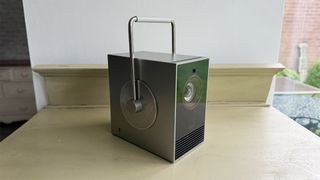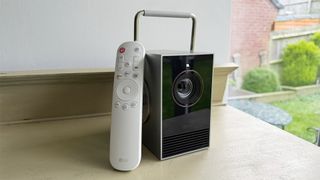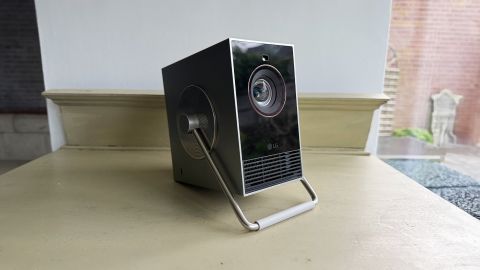Ultra-portable projectors are all the rage right now. All sorts of weird and wonderful designs have found their way onto our test benches in recent months – but none have looked quite as darned cute as the gleaming, metal-clad LG CineBeam Q. And, in some areas at least, no other ultra-portable projector has delivered the sort of picture quality the CineBeam Q is capable of, either…
Price

The LG CineBeam Q was £1299 when it launched in the UK, which made it comfortably one of the most expensive ultra-portable projectors in town. Happily, though, it’s now available for a far more attractive and competitive £799, while the US and Australia prices are $1300 and AU$2499 respectively.
This still puts it a chunk of change above impressive ultra-portable rivals such as Samsung’s The Freestyle Gen 2 and Anker’s Nebula Mars 3 Air. As we’ll see, though, the price actually ends up looking pretty reasonable for a projector with the relatively high level of design and specification the CineBeam Q offers.
Design

The CineBeam Q is arguably the best-looking portable projector we’ve ever tested. It’s certainly the shiniest, at least, thanks to the thick brushed metal finish that wraps around its sides and top edge, plus the large gleaming chrome-like circular mounting points for the built-in carry handle.
The handle itself continues the premium metal theme, except for a tasteful leathery cover that wraps around its horizontal part to make it more comfortable in your hand.
This touch of comfort is especially welcome given that the CineBeam Q is surprisingly heavy for something that looks so petite.

Projector type Three-laser DLP
Screen size Up to 150 inches (claimed)
Native resolution 3840x2160 (via DLP XPR pixel shifting)
Input lag with 60Hz 55ms
HDR support HDR10, HLG
Dimensions 14 x 8 x 14 cm
Closer inspection reveals a couple of clever bits about the CineBeam Q’s design to go with its generally opulent feel. First, the carry handle can actually be rotated right the way around the projector’s body, in a full 360-degree turn so that it can become a stand you can use to angle the projector’s lens up or down to almost any angle you need to get images on your wall, screen or even, just about, ceiling. A grilled finish to the handle’s circular attachment points, meanwhile, reveals that they also serve as outlets for a built-in audio system.
The front edge sports a nice glass finish – though note that since this lies over the lens, a bit of condensation can appear behind the glass for a few minutes after you first power the projector up if it’s been stored in a cold place.
The CineBeam Q ships with a glossy white remote control that follows the design of the ‘magic’ remote you get with LG’s TVs – minus the TV models’ point-and-click and spinning wheel navigation features.
Features

The LG CineBeam Q has some unusual features and specifications by ultra-portable projector standards, starting with the fact that it claims to deliver a huge 450,000:1 contrast ratio from an RGB laser lighting system. Getting decent black levels and contrast from convenience-focused projectors such as the CineBeam Q is rare indeed, and contrast claims in the region of 450,000:1 are practically unheard of.
Equally eye-catching is LG’s claim that the CineBeam Q can deliver 154 per cent of the DCI-P3 cinematic colour gamut most widely used for current high dynamic range mastering. This HDR talent is able to work on both HDR10 and HLG feeds in the CineBeam Q’s case, while its claimed 500 lumens of brightness is reckoned to deliver a picture up to 120 inches across.
Of course, it’s not exactly unusual for AV products of all sorts to make some rather… optimistic specification claims. As we’ll explain in more detail later, though, the CineBeam Q mostly actually does what it says on the tin.
As we’d expect of an ultra-portable projector these days, the CineBeam Q carries built-in wi-fi and a smart system, so you can instantly access content without any external devices. Unlike most projectors, though, the CineBeam Q’s smart system is LG’s excellent webOS (gen 6) platform. With its straightforward layout, largely excellent app nativisation and relatively intelligent content recommendation, webOS is a very pleasant upgrade on the Google or Android TV systems most projectors adopt. There’s support for LG’s ThinQ voice command system, too.
The projector supports AirPlay 2 mirroring/video casting/audio streaming from iOS and Mac devices, as well as the MiraCast wireless device mirroring platform – both with video support up to 4K/30Hz.
That said, there is a rather large and surprising hole in the CineBeam Q’s app coverage, since while the usual global big hitters (Disney+, Netflix, Prime Video, Apple TV etc) are present and correct, at the time of writing there is no sign of the catch up apps for the main UK terrestrial broadcast channels or the Freeview Play ‘umbrella’ app.
The CineBeam Q provides a handy automatic set-up system that, at least in theory, can sort out focus and keystone correction without any manual input every time the projector senses that it’s been moved. We say in theory because the keystone part of this auto set-up system doesn’t always get things quite right, requiring a short visit to the projector’s image adjustment menus.
These menus are easy to follow, though, and offer enough tweaks to completely fix any auto set-up mistakes.
A true plug-and-play projector needs to carry a built-in sound system, too. At first glance, the CineBeam Q seems to tick this box more than adequately thanks to the way it cleverly builds grilled sound outlets into the carry handle mounting rings. It turns out, though, that the sound emitted through these tidily integrated outlets is coming from a mono speaker rated to just 3W of power. With this in mind, it’s perhaps as well that the CineBeam Q also supports dual output Bluetooth pairing so that you can potentially output its sound to a pair of external Bluetooth speakers.
Perhaps surprisingly, the CineBeam Q doesn’t carry a built-in battery. It does, though, provide a USB-C port that enables the projector to be powered by an external USB power bank – though no such power bank is included with the projector.
The only other wired connection on the CineBeam Q is a single full-sized HDMI port that proves capable of passing Dolby Atmos to soundbars and AV receivers via eARC, as well as handling HDR and 4K feeds up to 60Hz refresh rates. This level of video support is good for such an affordable portable projector – though it does not, of course, extend to the 4K/120Hz and VRR features that the latest premium game consoles and PCs provide.
The projector takes just over 55ms to render images in its fastest setting, which is a solid result for an ultra-portable projector but not as lickety-split as serious gamers might like. Many TVs, by comparison, can now render images in 10ms or less.
The CineBeam Q’s menu system adopts the same design and many of the same feature options as LG’s latest TVs, right down to a long list of picture presets that includes a Filmmaker Mode designed to track industry picture quality standards.
One final lifestyle-focused feature of the CineBeam Q is its Light Drawing feature, where it can be set via the LG CineBeam app to output any of a series of richly coloured artworks, designed to create a specific tone or mood in your room.
Picture

The CineBeam Q’s pictures deliver the biggest instant ‘wow’ we’ve ever experienced with a portable projector. In fact, in two key picture areas in particular, it outguns many full-sized and much more expensive projectors.
The biggest shock comes from its handling of blacks. Dark scenes actually contain what look like genuine black tones, even with HDR content, with far, far less low-contrast greyness hanging over them than we’ve become accustomed to seeing from HDR-capable projectors. Especially ultra-portable HDR-capable projectors.
So good is the CineBeam Q in this respect, in fact, that it’s genuinely quite hard to fathom how it manages to do it. Particularly since with most picture presets the class-leading black levels are joined with a pretty respectable level of brightness by portable projector standards.
Put the brightness and black levels together, in fact, as LG’s projector does quite effectively in most of its presets, and while the 450,000:1 contrast ratio claim definitely feels like a stretch with any real-world content, the CineBeam Q certainly enjoys a contrast performance that’s worlds beyond the flat, washed-out look typically seen on budget and/or small projectors.

The other big CineBeam Q surprise – actually, shock – is how vibrant its colours are. In its brightest modes, including its extremely watchable default Standard setting, colours blaze off the screen with a vibrancy and intensity we’ve simply never seen before on an ultra-portable projector. In fact, only a handful of full-sized projectors can push colours to the sort of rich place the CineBeam Q can take them.
As well as being enjoyable to watch in itself, the CineBeam Q’s startling combination of contrast and colour also helps its pictures both deliver a stronger impression of HDR picture values than almost any other ultra-portable projector and combat the pollutive effect of any ambient light in your room.
The CineBeam Q also actually delivers a surprisingly credible 4K resolution feel. Not only by being able to take in native 4K sources, but by displaying them with a level of sharpness and detail that looks a comfortable cut above the HD resolution more typically associated with similarly priced ultra-portable projectors. You can actually see a slight reduction in the detail and clarity if the projector’s image placement means it needs to apply some auto keystone correction (as it usually does). But even then the picture still feels strikingly clean and detailed.
While the CineBeam Q is an eye-catching beast in the relatively aggressive picture modes that really help it stand out from the crowd, it’s also capable of delivering a surprisingly balanced and subtle picture in its Filmmaker Mode. Good though it is to see LG offering a mode that tries so hard to stay true to the native values of both SDR and HDR with a projector like the CineBeam Q, however, there is a problem: the Filmmaker Mode looks too dark. So much so that predominantly dark shots lose so much subtle shading and detail that they become almost unwatchable.
All is not lost for people who want a relatively natural-looking picture for serious movie nights, though, as the Cinema Home preset delivers an effective mid-point between the Standard and Filmmaker Mode presets.
There are a couple more niggles with the CineBeam Q’s mostly remarkable pictures to report, though. First, you can see rainbow effect (pure red, green and blue striping) flitting over stand-out bright parts of the picture. Second, as you might have guessed from the degree of difference we described between the CineBeam Q’s Vivid/Standard picture modes and its Filmmaker Mode, while the most vibrant, punchy settings deliver enjoyable pictures the likes of which we’ve never seen from such a small projector before, they can come on a bit too strong at times, especially when it comes to colour. But honestly, the fact that we’re even able to raise this as an issue speaks more to the CineBeam Q’s talents than its flaws.
Sound

There’s not much we need to say here for the simple reason that there’s not much sound to hear. The CineBeam Q’s 3W mono speaker completely lives down to expectations, failing to produce any significant volume or project what little sound it can muster any significant distance beyond the projector’s diddy bodywork.
There’s no bass at all, either, meaning that what little audio there is sounds tinny and thin, and the combined lack of power and frequency response means there’s no sense of escalation or growth to big soundtrack moments. It feels as though the projector’s cooling fans make more noise than the speakers do for much of the time, in fact.
Obviously it’s not easy for projectors as small as the CineBeam Q to squeeze in a decent speaker system. But the audio here comes up so far short that LG might as well not have bothered including it, really.
Basically you’ll need to factor in some sort of external sound system (maybe a pair of Bluetooth speakers) to use with the CineBeam Q for anything that isn’t essentially a silent movie, adding cost and inconvenience to a device that should be straightforward plug and play.
Verdict

The LG CineBeam Q is the cutest-looking and best-built mini projector we’ve seen, and in many ways its spectacular pictures break new ground for the ultra-portable market. Its webOS smart system feels like a breath of fresh air by smart projector standards, too.
It’s a pity there’s no support for the UK’s main terrestrial broadcaster catch-up services, though, and while its pictures in its most engaging picture modes are spectacular and brilliant for regular living room conditions, they can overcook things a bit for dark room viewing, while the more accuracy-focused Filmmaker mode is too dark to really enjoy.
The biggest black mark, though, is the sound, which is unforgivably bad. When dealing with a portable projector such as this, that’s a serious problem.
SCORES
- Picture 4
- Features 4
- Sound 1
MORE:
Read our review of the Anker Nebula Mars Air 3
Also consider Samsung's The Freestyle
Read our BenQ GV31 review

